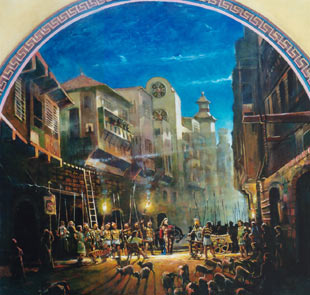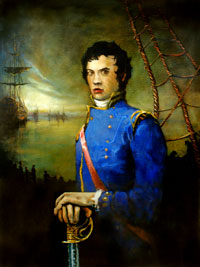|
||
|
||

Alexander and the Gordian Knot |
||

Commodore Perry transferrs his flag to the Niagara 1812 |
||
| These paintings have been copyrighted and used more than once in publications
and documentaries and book covers. It shows that any artist still has great
scope should he or she wish to properly research and produce a painting
that is definitive in its portrayal of some event of person who presently
lacks any adequate representation. What other 'gaps' might the 'journeyman'
painter tackle? Here is a list off the top of my head:
Milton of paradise lost fame
OK, so you can now see the possibilities should you want to research the subject matter, and have the technical skills to produce a painting that has both feeling, drama and definition. In my atelier my primary duty is usually to give students the skill so they can paint whatever style or method that might suit the period - or otherwise, should they determine something else is required. That is up to them and their reasoning. In this sort of work it is important for future copyright use that the artist refrain too much from 'stamping their personal style' on the work; instead making the painting identify with the time and place or the person and particular event. This sometimes needs much research - but the rewards are great should your portrait or work become the definitive one, as did my Fletcher Christian. You see it was well researched had the benefit of not looking like Mel Gibson, Marlon Brando or Erol Flynn! Beware that, like the novelist or actor, you might become so attached to some period or person it could almost become obsessional - as I nearly did with my late 18 century era of sail and romanticism. Finally you need to put these images where folk who need them can see them and this means originally on the web, and perhaps giving them away free (within defined parameters) to educational and other non-profit organizations that require them from time to time. |
||
|
OR ... back to lesson list |

